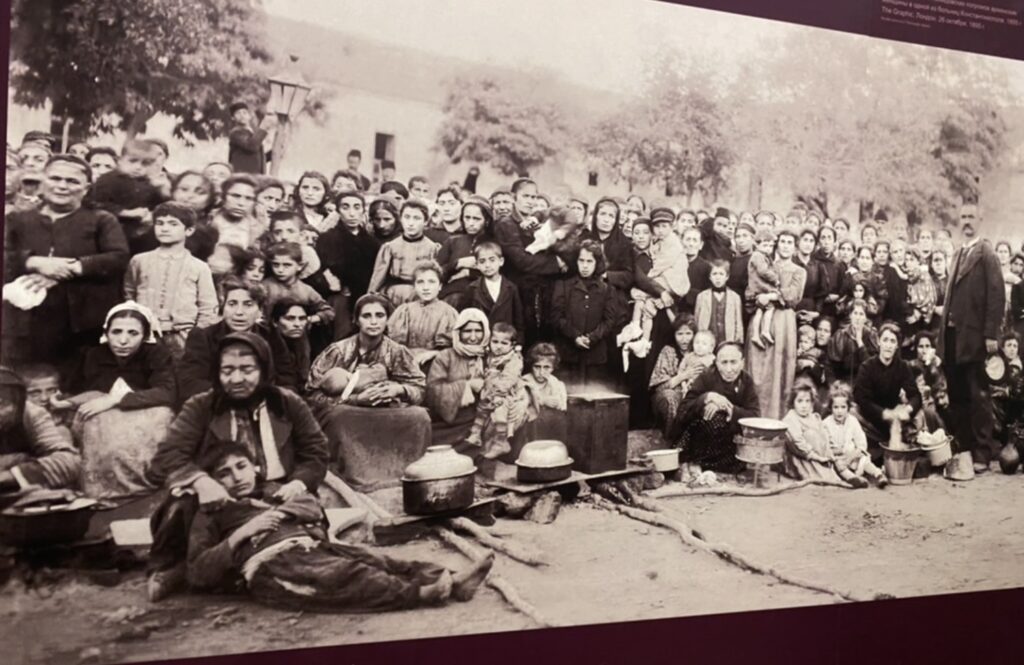The Unknown Saint of Armenia – The Devout and Beautiful Hrispime
Rev. Dr. Mae Elise Cannon
During my September 2022 travels to Armenia, I had the opportunity to visit ancient churches and learn about the oldest Christian State. Armenia’s king converted to Christianity and made Christianity the state religion in the early 4th century. Proud of their Christian lineage, the Armenian Orthodox Church centers the community around the Etchmiadzin Cathedral, considered by many to be the oldest cathedral in the world. Archbishop Vicken Aykazian, Ecumenical Director and Diocesan Legate of the Diocese of the Armenian Church of America (Eastern) led our delegation from Churches for Middle East Peace (CMEP). Our purpose was to learn about the late 19th and early 20th century of genocide against the Armenians and to have a better understanding of the current conflict between Azerbaijan and Armenia. I did not expect how spiritually moving I would find our pilgrimage, which included the sharing of some of the early stories of faithfulness and deeply rooted Christian faith in the ancient country of Armenia.
My favorite piece of Armenian history is that of Saint Hripsime (pronounced Rip-se-may). Hripsime lived during the third century, a beautiful woman who escaped from the clutches of an evil emperor in Rome and committed herself to live a simple life of Christian mission in response to her love of Christ.
According to legend, Hripsime belonged to a community of 35 virgins. Hripsime was the most beautiful among the women, and she captured the attention of the Roman Emporer Diocletian. The head of the women (who later became nuns) was Sister Gayane, who supported Hripsime in her desire to commit her life to Christian service. To avoid the emperor’s advances she, along with the other women, fled Rome – first to Alexandria and then to Vagharshapat (now Etchmiadzin) in Armenia. The story of Hripsime’s courage and commitment to Christ did not end well. There are two different versions of the story. One where the local king Tiridates III pursued her and when she refused his advances she was burned alive.
The more common ending to the story continues when Diocletian refused to give up hope and pursued Hripsime, Gayane, and the other women. Hripsime responded that she would not marry the emperor since she was betrothed to Jesus Christ, as were the other women. The legend continues that Hripsime heard a voice from heaven saying “Be brave and fear not, for I am with you.” Diocletian commanded that Hripsime be tortured. The retelling of her death is brutal, and Hripsime died a martyr. Inspired by Hripsime’s faith and commitment, the other sisters submitted themselves also to be martyred for their faith. Legend has it that the soldiers that killed them were punished by God because of their actions and became tormented and unhinged. Gregory the Illuminator, attributed as having introduced the Armenian people to Christianity, had to intervene leading the king of Armenia to repent and to come to the Christian faith. Gregory the Illuminator became the head of the church in Armenia, the first Catholicos, with the headquarters being at Etchmiadzin. Today, the Catholicos remains the head of the church in Armenia. While the details of the story of Hripsime are largely uncertain, it is confirmed that she and her companions were in fact martyred in Armenia in about 290 AD. She, along with Gayane and the other virgins, is considered one of the mothers of Armenian Christianity.
Today, Armenian Christians continue to fear that their faith is under threat. The ongoing Nagorno-Karabakh conflict, which began in the 1990s with the fall of the Soviet Union and the redistribution of land to form contemporary states including Azerbaijan, threatens the sustainability of the Christian community residing in Artsakh (Nagorno/Karabakh). For Armenians, the genocide of the early 20th century continues to be present in their historical memory as the Turkish regime perpetuated the mass murder of more than one million Armenian Christians and other Eastern Christian communities.
The Nagorno-Karabakh first war occurred in the early 1990s and then, unresolved, flared up again in September 2020. Churches for Middle East Peace (CMEP) issued a statement in December 2020 claiming “Now is the Time for Sustaining Peace Between Armenia and Azerbaijan.” Asserting “Now is the time to put away guns, the angry rhetoric, the desires for revenge, and the claims of victory and betrayal. Now is the time for peacemakers.”
It was not until 2021 that President Biden and the United States acknowledged the genocide of the Armenian people on April 24, Armenian Remembrance Day (Meds Yeghern), saying, “We honor the victims of Meds Yeghern so that the horrors of what happened are never lost in history. And we remember so that we remain ever-vigilant against the corrosive influence of hate in all its forms.”
In September 2022, further escalations around the Nagorno/Karabakh territories continued, and CMEP called for an end to the Hostilities between Armenia and Azerbaijan. CMEP stated: “Armenians see the region as historically Armenian, given the centuries-long presence of Armenian communities, churches, and ancient Christian sites. Many of these sites have been intentionally destroyed during the two major wars in 1988-1994 and 2020 between Azeri and Armenian forces, including hundreds of churches damaged or demolished and thousands of ancient Armenian crosses carved into stone (khachkars) having been destroyed.” CMEP supported Secretary Blinken’s September 12, 2022 statement calling for an “immediate end to hostilities” and the safety and protection of all people. In addition, CMEP called for the protection of the Armenian Christian community residing in the contested territories and the protection of historical and present Christian sacred sites.
Today Saint Hripsime’s story of faithfulness and courage is largely forgotten. And the majority of Americans are unaware of the rich history of Christianity found in contemporary Armenia and in the historical territories of the Armenians. May we be inspired by Hripsime’s faithfulness to never give up hope and to always remain committed to the Gospel. And as we consider the contemporary geopolitics of the Armenian struggle, may we advocate for equality, human dignity, and peace for all people living in the land. Advocating for peace and standing up for human rights, as an expression of our faith in the good news of the Gospel of Christ.
Let Us Pray:
Lord, we lament and grieve the history of Armenian Christianity and the genocide and destruction of communities committed and faithful to Christ – from the third century and the time of Hripsime to the 20th century and the holocaust of the Armenian people. Lord God, bring your protection and your peace so that followers of Christ – and all people – might live in safety and without worry. Intervene so that a peaceful solution might be found to the current political conflict where all people could live in dignity and with the potential for a prosperous future. Have your way, Lord God, O Prince of Peace. In the name of Christ, Amen.


About the Author: Rev. Dr. Mae Elise Cannon is the executive director of Churches for Middle East Peace and an ordained pastor in the Evangelical Covenant Church (ECC). Cannon holds an MDiv from North Park Theological Seminary, an MBA from North Park University’s School of Business and Nonprofit Management, and an MA in bioethics from Trinity International University. She received her first doctorate in American History with a minor in Middle Eastern studies at the University of California (Davis) focusing on the history of the American Protestant church in Israel and Palestine and her second doctorate in Ministry in Spiritual Formation from Northern Theological Seminary. She is the author of several books including the award-winning Social Justice Handbook: Small Steps for a Better World and editor of A Land Full of God: Christian Perspectives on the Holy Land. Her work has been highlighted in The New York Times, The Washington Post, CNN, Chicago Tribune, Christianity Today, Leadership Magazine, The Christian Post, Jerusalem Post, EU Parliament Magazine, Huffington Post, and other international media outlets.
Any views or opinions contained herein are solely those of the author and do not necessarily represent those of Churches for Middle East Peace (CMEP).

